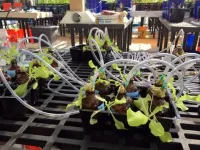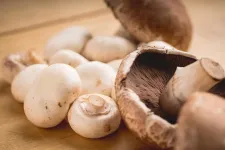(Press-News.org) Carbon nanotubes are tiny. They can be a hundred thousand times smaller than the width of a human hair. But they have huge potential.
Products manufactured using carbon nanotubes include rebar for concrete, sporting goods, wind turbines, and lithium batteries, among others.
Potential uses of carbon nanotubes could extend to diverse fields, such as agriculture, biomedicine and space science.
But as we use more carbon nanotubes to make things, we also increase the chances that these nanotubes enter different environments and ecosystems.
"That makes it important to understand how carbon nanotubes behave in these environments," says Yu Yang, a member of the Soil Science Society of America.
In a new study, Yang and his colleagues describe a way to measure levels of a specific kind of carbon nanotube in plant tissues. Their research was recently published in Journal of Environmental Quality.
Carbon nanotubes may make their way into agricultural fields and food products. There, they can pose a threat to human and environmental health.
"Knowing how to measure carbon nanotubes in the environment is crucial to understanding their environmental fate and effects," says Yang.
To mimic the nanotubes in the environment, Yang and colleagues grew hydroponic lettuce in the presence of carbon nanotubes. Then they analyzed the lettuce leaves for traces of carbon nanotubes.
Yang found this method could detect small amounts of carbon nanotubes in the leaves, stems and roots of the lettuce plants.
"We have developed a method to address the challenging issue of quantifying carbon nanomaterials in the environment," says Yang. "These findings can help guide the sustainable application of carbon nanotubes in natural environments."
The challenge in measuring carbon nanotubes in the environment is that they are made of carbon. All living things on Earth - including humans and plants - have carbon as a key building block.
The task Yang and colleagues faced was to distinguish between carbon in living material from carbon in carbon nanotubes.
A single layer of carbon atoms arranged in a honeycomb pattern is called graphene. A carbon nanotube is a sheet of graphene rolled into a tiny cylinder.
Carbon nanotubes made of a single sheet of graphene are called single-walled nanotubes. Layering multiple tubes within others yields multi-walled carbon nanotubes.
Scientists can add different molecules to carbon nanotubes. Adding these molecules can change their characteristics. They might dissolve more easily in solvents, for example.
"Carbon nanotubes with molecules added on could be used in the fabrication of nanocomposites, biomedicine, and chemical or biological probes," says Yang.
In previous research, Yang's group quantified multi-walled carbon nanotubes in plants. But no one had measured if this kind of carbon nanotube with a specific molecule added on gets into plants.
The researchers used a technique called programmed thermal analysis. In this approach, materials are heated in a controlled manner in different environments - say plus or minus oxygen, for example.
How different materials react to being heated in different environments can provide big clues about these materials.
Yang and colleagues found they could use programmed thermal analysis to detect the carbon in the nanotubes. Using these data, they could also tell apart the carbon in carbon nanotubes from the carbon in plants.
This is the first study to measure levels of this kind of carbon nanotube in plants using the thermal analysis. "That's crucial for understanding carbon nanotube fate in the environment and estimating potential human exposure," says Yang.
Yang is now working on detecting even smaller amounts of carbon nanotubes in the environment.
"We also want to try to measure carbon nanotubes with different molecules added on," says Yang. He also plans to expand test materials beyond lettuce plants. "We want to test this approach in different environments."
Ultimately, the goal is to advance the application of carbon nanotubes. "Being able to accurately measure carbon nanotubes in the environment can promote their sustainable use," says Yang.
INFORMATION:
Yu Yang is a researcher at the University of Nevada-Reno. This work was supported by National Science Foundation.
February 24, 2021 - The second study published in as many months has identified another reason to add more mushrooms to the recommended American diet. The new research , published in Food & Nutrition Research (February 2021), examined the addition of mushrooms to U.S. Department of Agriculture (USDA) Food Patterns resulting in the increase of several micronutrients including shortfall nutrients, while having a minimal to zero impact on overall calories, sodium or saturated fat.
Dr. Victor L. Fulgoni III and Dr. Sanjiv Agarwal looked at the nutritional ...
Small changes to people's writing style can reveal which social group they "belong to" at a given moment, new research shows.
Groups are central to human identity, and most people are part of multiple groups based on shared interests or characteristics - ranging from local clubs to national identity.
When one of these group memberships becomes relevant in a particular situation, behaviour tends to follow the norms of this group so that people behave "appropriately".
The new study - by the University of Exeter, Imperial College London, University College London and Lancaster University - demonstrates that group normative behaviour is reflected in a person's writing style.
It also shows that assessing ...
New research has highlighted the value of recycling general anaesthetic used in routine operations.
In the UK, healthcare accounts for more than five per cent of national greenhouse gas emissions, and as much as 10 per cent in the US. Inhaled general anaesthetics are particularly potent greenhouse gases and as little is metabolised almost all that is administered is breathed out to end up in the atmosphere. The commonly used anaesthetic agents have been considered to vary considerably from as little as 1.5 for sevoflurane to more than 60 kg carbon dioxide equivalence for an hour's anaesthetic with desflurane. However, research led by a team from the University of ...
Researchers from University of British Columbia published a new paper in the Journal of Marketing that examines whether and how the use of 'ugly' labeling for unattractive produce increases sales and profit margins.
The study, forthcoming in the Journal of Marketing, is titled "From Waste to Taste: How "Ugly" Labels Can Increase Purchase of Unattractive Produce" and is authored by Siddhanth (Sid) Mookerjee, Yann Cornil, and JoAndrea Hoegg.
According to a recent report by the National Academies of Science, Engineering and Medicine (2020), each year in the U.S. farmers throw away up to 30% of their crops, equal to 66.5 million tons of edible produce, ...
WEST LAFAYETTE, Ind. - New technology from Purdue University and Indiana University School of Medicine innovators may one day help patients who suffer devastating vocal injuries from surgery on the larynx.
A collaborative team consisting of Purdue biomedical engineers and clinicians from IU has tissue-engineered component tissue replacements that support reconstruction of the larynx. The team's work is published in The Laryngoscope.
The larynx is a very complex human organ consisting of outer cartilage for structural support, inner muscle that contracts to permit voicing, swallowing, and breathing, and inner vibratory lining.
Currently, thousands of patients each year with laryngeal cancer ...
RICHLAND, Wash. - No one went to Oktoberfest in 2020, but chances are those who attended in the past are still thinking about it.
In a case study of the famous German beer festival, researchers tested the theory that events which create memorable experiences can increase life-satisfaction. This deep connection with customers has big benefits for associated businesses, according to Robert Harrington, lead author of the study recently published online in the International Journal of Contemporary Hospitality Management.
"If you can do something that transforms people even a little bit, it can have a huge impact on the success of your company and your brand," said Harrington, professor and director of the School ...
A team of engineers has identified the 'violent' physical processes at work inside the lungs which cause wheezing, a condition which affects up to a quarter of the world's population.
The researchers, from the University of Cambridge, used modelling and high-speed video techniques to show what causes wheezing and how to predict it. Their results could be used as the basis of a cheaper and faster diagnostic for lung disease that requires just a stethoscope and a microphone.
Improved understanding of the physical mechanism responsible for generating wheezing sounds could provide a ...
A team of researchers concludes that a game-theory approach may offer new insights into both the spread and disruption of viruses, such as SARS-CoV-2. Its work, described in the journal Royal Society Interface, applies a "signaling game" to an analysis of cellular processes in illuminating molecular behavior.
"We need new models and technologies at many levels in order to understand how to tame viral pandemics," explains Bud Mishra, a professor at NYU's Courant Institute of Mathematical Sciences and one of the paper's authors. "At the biomolecular level, we explain how cellularization may be understood in ways that stymie disease and encourage healthy functioning."
The analysis, which also included William Casey, ...
A new study involving researchers from the University of Oxford and the Chinese Center for Disease Control and Prevention (China CDC) has examined the change in overall and cause-specific death rates during the three months of the COVID-19 outbreak in early 2020. The results are published today in The BMJ.
In China, the emergence of COVID-19 was first reported during mid-December 2019 in Wuhan city, Hubei province. Coinciding with the January 2020 festivities for the Chinese Lunar New Year, the virus spread rapidly across China. This led to a national lockdown on 23 January 2020, which continued until early April.
The ...
Night 'owls' may be twice as likely as morning 'larks' to underperform at work and to run a heightened risk of early retirement due to disability, finds research published online in the journal Occupational & Environmental Medicine.
Given the move to lengthen working life and delay pension eligibility, it might be worth factoring in a person's chronotype, suggest the researchers.
Morning chronotypes, or 'larks' tend to do better early in the morning, while evening chronotypes, or 'owls' do better in the evening. Chronotype is largely genetic, but environmental factors, such as exposure to daylight, work schedules, and family life can also influence it.
Owls don't usually fall asleep early enough to get the recommended 7+ hours of sleep on ...

